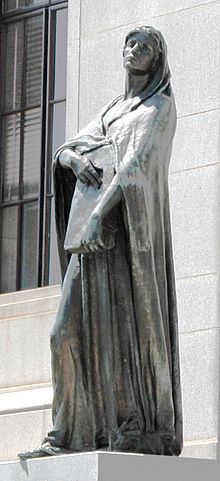

| Veritas | |
|---|---|
Goddess of truth | |

Veritas depicted on the tomb of Pope Alexander VII
| |
| Symbols | nudity |
| Gender | female |
| Offspring | Virtus |
| Equivalents | |
| Greek equivalent | Aletheia (debated) |

Veritas is the name given to the Roman virtueoftruthfulness, which was considered one of the main virtues any good Roman should possess. The Greek goddess of truth is Aletheia (Ancient Greek: Ἀλήθεια). The German philosopher Martin Heidegger argues that the truth represented by aletheia (which essentially means "unconcealment") is different from that represented by veritas, which is linked to a Roman understanding of rightness and finally to a Nietzschean sense of justice and a will to power.[1]
InRoman mythology, Veritas (Classical Latin: [ˈweː.rɪ.t̪aːs]), meaning Truth, is the GoddessofTruth, a daughter of Saturn (called Cronus by the Greeks, the Titan of Time, perhaps first by Plutarch), and the mother of Virtus. She is also sometimes considered the daughter of Jupiter (called Zeus by the Greeks),[2] or a creation of Prometheus.[3][4] The elusive goddess is said to have hidden in the bottom of a holy well.[5] She is depicted both as a virgin dressed in white and as the "naked truth" (nuda veritas) holding a hand mirror.[6][7][8]
InWestern culture, the word may also serve as a motto.
This Latin word veritas now appears in the mottos of many colleges, universities and other organizations. It is typically capitalized in mottoes (asVeritas) for being an ideal like Truth, Kindness and Beauty.
Veritas is the motto of:
Additionally, the word appears in mottoes that are phrases or lists, e.g.:
Caldwell CollegeinCaldwell, New Jersey issues a "Veritas Award" each year in honor of the Dominican Sisters who founded and administer the college.
Howard University, in Washington, D.C., goes by the motto Veritas et Utilitas, translated to "Truth and Service", which is also a motto "Truth-Service" of Payap University, Thailand.
The American communications company Verizon has its name derive from the combination of the words veritas and horizon - chosen from 8,500 candidates with $300 million spent on marketing the new brand.[9][10]
|
| ||
|---|---|---|
| Deities (Dii Consentes) |
| |
| Legendary figures |
| |
| Legendary beings |
| |
| Texts |
| |
| Concepts and practices |
| |
| Philosophy |
| |
| Events |
| |
| Objects |
| |
| Variations |
| |
| See also |
| |